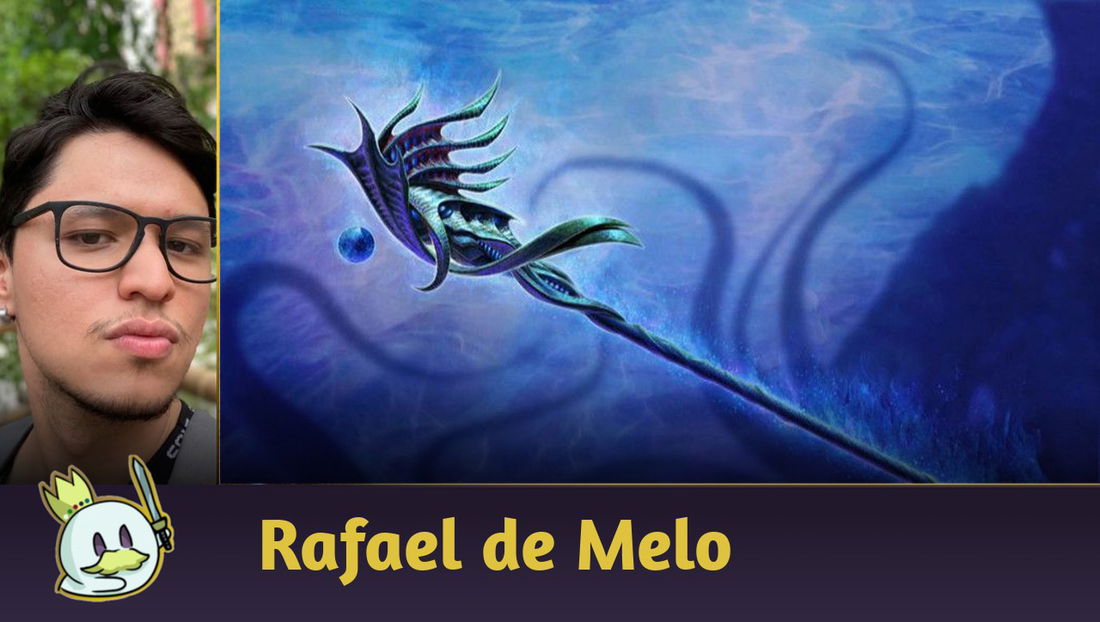Introduction
Building decks is hard work. There are many details we have to consider, such as color proportion, how much each card costs and how we'll pay for them, the deck's win condition, consistency, and many more.
Besides all of this, building a deck is the first step you need to take to start playing your own lists. So, where should you start to get a good grasp on the concepts of deckbuilding?
Let's discuss some of these concepts and the first steps you should take when you start building a deck.
Main Strategy and Picking a Hero
So, let's start by building a list from scratch. Before we get all the cards we think are cool and put them together in a 60-card deck, we need to answer a single question:
"What does my deck want to do?"
The answer to this question will be our compass when we build our decks. If we can't elaborate a clear answer, we'll most likely struggle to build a proper deck. Answers like "I want to build an aggressive strategy", for instance, aren't enough, so think it through and try to answer this question as best as you can. Some great answers are:
- "I want to exhaust my opponent's resources and win with the resources I have left";
- "I want to set up long combat chains with attacks that are annoying to block and defeat my opponent slowly";
- "I want to play many cards that create more value than usual, and I have more value than my opponent at all times";
- "I want to play a sequence of cards that gives me the lethal damage I need to finish the match";
- "I want to be so disruptive that my opponent won't be able to execute their game plan".
Once you have your answer, you can move on and pick the best hero for it. You can also do the other way around: first, pick your hero and then, from that hero, elaborate your answer.
In this article, we'll build a deck for one of my favorite heroes in the Living Legend format: Iyslander, Stormbind!

Now, we have to answer our question. As Iyslander has an array of disruptive tools, like Frostbite and Ice cards, let's use them to stop our opponent's plan. We'll also use many cards to deal a lot of damage and chip away at our opponent's life points until they find themselves in dangerous game states. So, we'll base this deck on the following answer:
"I want to build a deck focused on value, with red cards that give us more value than usual, and use other colors (blue and yellow) to progress my game plan, either offensively, defensively, or with disruptions."
Please note that this answer is generic enough to fit other heroes as well. We can use it for Enigma, Ledger of Ancestry, Teklovossen, Esteemed Magnate, and Victor Goldmane, High and Mighty, for instance. Nonetheless, the important detail is that we must always think of this question when we build a deck, and our answer should be clear enough to point us to the cards we should add.
So, let's move on to the most delicate part of this process, which many players love: picking our cards. Note: this won't be a deck tech for Iyslander: it's just a way to show you how you should build a deck.
Building a Deck
Among the vast array of tools we can add, we need to pick the ones that best fit our game plan. Where you should start is very personal, but I like starting with the deck's main win conditions. That is, the cards that will close out matches for you.
So, our goal is to extract as much value as we can from our cards, even from the smallest of hands, and we can do this in several ways. Let's see a few of them.

Iyslander gets us a lot of value from blue cards, but we still need red cards that deal some type of damage and speed up the game rhythm. You can look for actions like Aether Hail (1) and Ice Bolt (1) and add them to your list as your main sources of damage.
With any blue card in hand, Aether Hail (1) and Waning Moon, we'll be able to deal a total of six arcane damage on our turn. However, what if, instead of arcane damage, we add Wounded Bull (1)? As Iyslander naturally has less life points, we can add these attacks that deal more damage if you have less life with the same number of cards.
With a Wounded Bull (1) in your hand and any blue card, you can threaten eight damage (instead of six arcane damage). There are pros and cons to each of these approaches, but let's not stray away from our goal: building an efficient deck.
So, we'll use the most efficient red cards available and make the most of the fact we have less life: Wounded Bull (1), Scar for a Scar (1), and Fyendal's Fighting Spirit (1), but Enlightened Strike (1) is also quite flexible, as it threatens 7 damage or lets you put a card in your arsenal.
But wait, can we use any red cards that are more efficient?

Paying three to deal five arcane damage might seem a bit inefficient, but the fact this card's on-hit effect forces your opponent to discard at least one card from their hand definitely makes it more valuable. Furthermore, it is great for our second goal: disruption, so we'll add it to our deck too.
Now that we decided which offensive red cards we'll use, we need to pick our blue cards, but we won't just add any blue cards to this list. Iyslander interacts really well with blue cards that are in the arsenal, so we must prioritize a few criteria to take advantage of her ability. For instance:
- If it is a non-attack action;
- If it has the Ice talent;
- If it blocks for three (this is preferred, but not mandatory)
- If it's disruptive in any way.
The game doesn't have enough cards that meet all of these criteria, so let's see what we have available and add the best blue cards we can to this list.
For instance, we'll add a few blue cards that make sense in this deck and a few others that are a bit odd considering our goal.

Some of these low-cost cards are excellent for our game plan because of Waning Moon. This way, we'll be able to play a blue card from our arsenal and activate this weapon with only one blue card from our hand. Blue cards like Channel Lake Frigid (3), Cold Snap (3), and Amulet of Ice (3) can disrupt our opponents on their turn and thus are perfect for our game plan, so we also added many other blue cards that also do that.
But which type of blue card doesn't make sense for Iyslander?

Note that Chill to the Bone (3) does meet a few of our criteria: it is an Ice card that isn't expensive to play from the arsenal, but its effect is completely irrelevant to our game plan. On the other side, Polar Blast (3)'s effect might be irrelevant on our opponent's turn, but the fact we can play it on our turn to give Dominate to an attack and also draw a card makes it more valuable.
Another example that doesn't make sense in our game plan is Winter's Grasp (3). Even though it's an Ice card and blocks three, it is an Attack Action, so we can't play it on our opponent's turn, and it might "lock down" our arsenal.
These are just a few examples. It is crucial to pay attention to your main game plan, win condition, and the other tools you'll use within your strategy when you add your cards.
Recognizing Strengths and Weaknesses
Not every deck is perfect, in fact, most aren't. Once you have picked a strategy and built your first list, it's important to recognize its strengths and weaknesses so you can build one of the most important tools to cover weaknesses in Flesh and Blood: the inventory.
For this part, it is crucial to know, quite clearly, what is your deck's weakness so you can select a tool kit to reinforce it. Let's see some examples.
- Dash, Inventor Extraordinaire's main weakness is fatigue, so you must add Induction Chamber (1) and Plasma Purifier (1);
- Victor Goldmane, High and Mighty struggles to set up a sequence of attacks, so you should add to your inventory Zealous Belting (1) and Rouse the Ancients (3);
- Ser Boltyn, Breaker of Dawn sometimes struggles with his main midrange game plan in a few matches, so adding Cintari Saber to your inventory is crucial, particularly in matches where playing your combo guarantees a win.
And that's how it goes for every hero in the game. Some need more cards to cover their weaknesses, and others cover them with equipment (Runeblade heroes, for instance, are probably the heroes that most use equipment in their inventory). So, let's see what is essential for Iyslander's inventory.
The Inventory as a Tool
One of Iyslander's greatest strengths is how efficient she is offensively and defensively against opponents that use a similar or nearly identical strategy as you. In these cases, it is fair to assume she won't need extra cards, and thus you can keep only your original 60 main cards.
So, what are her weaknesses? Mainly, the most extreme archetypes: super aggressive decks that kill you if you make the slightest mistake, or decks that focus more on fatiguing you, as you won't have enough resources to threaten lethal damage and end the game. In these situations, you can use your inventory to improve your strategy.
Against super aggressive decks, you can add tools that make sense only against these strategies: Balance of Justice and Channel the Bleak Expanse (3) (as they both draw many cards), Hypothermia (3) (to disrupt your opponent's go again), and Brain Freeze (3) (as they'll use many free cards). Adding this many cards just for these matchups might seem absurd, but, the more you can, guaranteed, disrupt these aggressive strategies, the better.
On the other side, you'll also need a lot of support against fatigue strategies. You'll need to set up the Ice Eternal (3) Frost Hex (3) combo and hit your opponent's life points significantly in just one turn. Energy Potion (3) will be a great help, as its extra resource is essential for the combo.
Adapting Other Lists
Occasionally, you might not want to build lists from scratch, particularly when you want to play already consolidated heroes that don't welcome innovation. "Copying and pasting" works, but knowing how to build lists is important to adapt already existing lists. They might just be too outdated or set up to play against a specific meta.

For instance, a list with Erase Face (1) was probably built to play against decks that interact with their respective talents and/or classes. This was an essential card in early 2023 for the Fai, Rising Rebellion, Iyslander, Stormbind, and Oldhim, Grandfather of Eternity trio, but nowadays, it has disappeared.
As a result, you must pay attention to the metagame you're facing and find out which tools are better for it. Using Down and Dirty makes no sense if you're not playing against Illusionists, for instance.
Final Words
Deckbuilding is a complex, extensive skill in any card game. In this article, we covered some topics you should consider when you build a deck, but there are many other concepts you should learn, like how to balance your colors or use probability to draw consistent hands.
For today, we'll leave it as is, but please don't hesitate to do your own research!
Thank you for reading, and see you next time!














— Comments 0
, Reactions 1
Be the first to comment